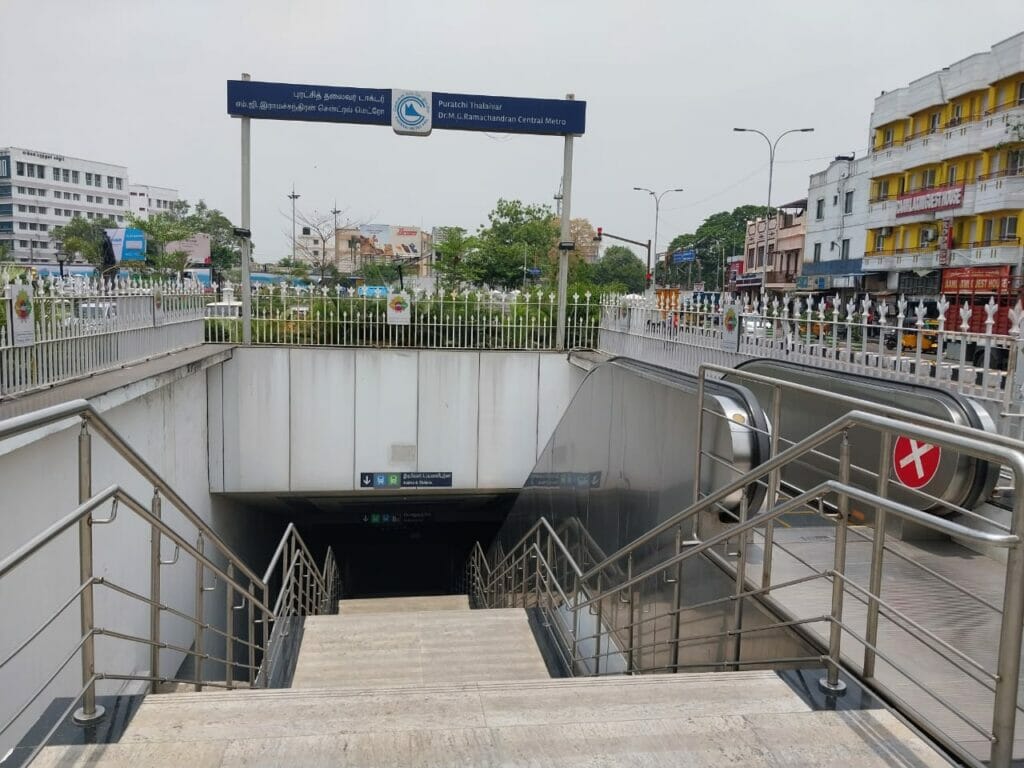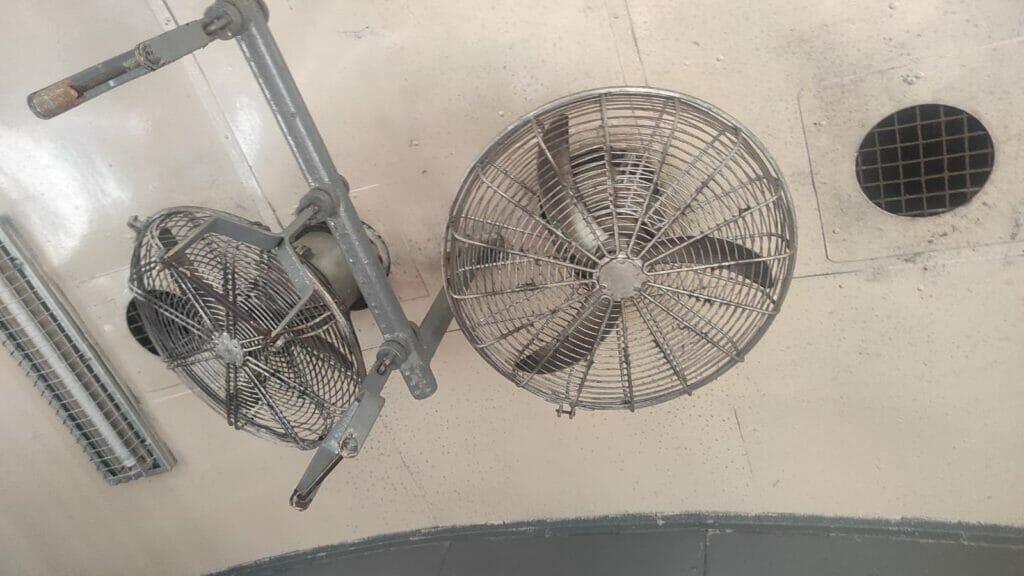“The wait for an MTC bus on hot days is pushing me to use autos,” says M Priyanka. “I take the 12G bus to go to my office in Mylapore from KK Nagar. There is no bus shelter in Munusamy Salai in KK Nagar from where I board the bus. The trees around the stop, which provided some respite, were chopped and not replanted. The wait for buses is also unpredictable. So now I use autos.”
Priyanka used to pay nothing to travel on the MTC bus, thanks to bus transport being made free for women by the state government. However, she now spends Rs. 500 per day on transport “One-third of my income is spent on commute,” she says.
Public transport and related infrastructure in Chennai are not suitable for commuters to use when the weather is extreme.
Be it a lack of bus shelters in Chennai, a roof-less foot-over bridge (FOB), or poor frequency of buses- they all have an impact on the commuter’s ability to use public transport during harsh summers and heavy rains.
A properly functioning public transport must provide easy access to education, employment and essential services, according to C40. But when public transport is not climate resilient, its functionality is reduced.
What steps must be taken to make public transport in Chennai climate resilient?
Read more: GPS speakers, panic buttons, pink buses and more: What the MTC rider in Chennai can look forward to
Chennai’s buses are not climate resilient
The frequency of buses is a key issue faced by commuters during summers and monsoons in Chennai.
Dhanam, a domestic worker, talks about the pain of waiting for the bus on hot days. “At 2 pm, in kathiri veyil [hottest time of the year], I take the bus to get to work. The 21G bus that I have to board is very infrequent. Sometimes, I have even waited for 40-45 minutes near Chelammal College. The heat is unbearable despite waiting under a shelter. By the time I get to work, I have a massive headache,” she says.
Dhanam cannot afford to pay for autos too.
A transport official confirmed that 21G’s frequency is every 30 minutes during non-peak hours.
Wait times for buses must be optimised to make bus transport more climate resilient. If more commuters are forced to contend with harsh sun and rains, they will be forced to move away from public transport for a large part of the year.
It is not just the buses but even allied infrastructure such as bus shelters are not suitable for extreme weather.
“The bus shelters are also not completely waterlogging-free. If there is no elevated platform to stand on, we are forced to stand in the water or completely away from the bus stops,” says Krishnamurthy, a septuagenarian bus user from T Nagar.
Chennai is also dotted with bus shelters made of metal. Earlier, the bus shelters were made of concrete. “The metal ones are easier to maintain and cheaper to procure,” says Santhosh Loganaathan, Deputy Manager of the Institute for Transportation and Development Policy (ITDP).
But metal is not heat-proof. There were around seven people sitting on a metal seat under a bus shelter in Nandanam, near the metro station at around 3 pm. The seat was burning hot.
“I would rather sit on something hot than stand and become more tired in the sun,” a commuter says.
The physical condition of the buses also leaves a lot to be desired. Old buses plying Chennai streets leave commuters exposed to adverse weather.
“It becomes like an oven when the windows are stuck and do not open, especially in Deluxe MTC buses,” observes Priyanka. “Better maintenance of buses and functional windows will make the bus ride more comfortable.”
The roofs of buses tend to develop water leaks during monsoon say many commuters.
“The maintenance of buses happens only when people raise complaints,” says the transport official. “Only engine repairs happen regularly.”
Read more: How safe is public transport in Chennai?
Suburban and MRTS trains are relatively more climate resilient than buses
Siddharth Subramanian who occasionally takes the Thirumayilai MRTS observes that the trains are sturdy and rains do not affect its functioning. “But while waiting at the stations, which are open and often don’t have working fans, it is unbearable during the summer,” he adds.
Certain suburban stations do not have roofs on the platforms. For instance, at the Mambalam railway station towards the West Mambalam Station Road, people stand under the open sky while waiting to board a train that goes towards the Beach Station.
Commuters also shared their experience of how on a train that went towards Chengalpattu from Beach, the fans were not working during hot summer days.
Subways that are used by the public to get to the stations also get flooded during rain. For instance, the subway from Park Town MRTS faces frequent flooding and is unusable when it rains, leaving commuters wading through the water to get to the trains.
The air-conditioning in the metro trains attracts passengers to use the mode. If there is an option to choose between a bus, suburban train, MRTS train and a metro train, many will pick the metro.
“When there was no metro earlier, I used the suburban trains from St. Thomas Mount to Egmore to get to work. After entering my office, I used to rush into the washroom to use my deodorant since I used to sweat a lot on suburban trains. However, I do not sweat as much in the metro,” says a metro user.
The design of some metro stations poses issues to commuters on hot and rainy days.
Krishnamurthy talks about the Guindy metro station. “The staircase and the escalator that goes up to the station have no roof. It is hot during summer. During rains, the escalator stops functioning. We have to climb the staircase that gets slippery.”
Central and Nanganallur metro stations also have entrances without roofs.

The lack of proper last-mile connectivity is a puzzle yet to be solved by CMRL and proves to be a deterrent for many to take the metro. Commuters will have to be exposed to the elements in their quest to get to the nearest metro station.
Steps to make public transport climate resilient
To make buses more resilient, C40 suggests that painting bus roofs with white can reduce heat impact.
“It could turn out to be a superficial solution as repainting and maintaining the white roofs could be a lot of effort,” says Santhosh.
“Procuring more AC buses must be the way ahead. It is only slightly more expensive than the normal buses. But it will encourage more people to use AC buses than turn to privately owned vehicles,” says Santhosh. “AC buses are weather-sealed and will maintain a constant and comfortable temperature inside the buses, irrespective of the weather outside. This will also prevent the commuters from inhaling toxic fumes due to the sealed nature. In normal buses, they are susceptible to air pollution.”
He also suggests that bus shelters must be greened to reduce heat impact. “Currently bus shelters are placed with the perspective of advertisements and not to realise their purpose. That has to change,” says Santhosh.
“We can look at whether wood seats in bus shelters would be more climate resilient. Again we need to explore its viability during monsoon,” says Sumana Narayanan, Senior Researcher with Citizen, consumer and civic Action Group (CAG).
She also suggests increasing the frequency of buses will bring down the wait time, thus reducing climate impact.
“Recognising the need to improve the climate resilience of public transport across the city, the Chennai Unified Metropolitan Transport Authority (CUMTA) has formed a sub-committee to make policy decisions on resilient public transport,” says the Special Officer of CUMTA, I Jeyakumar.
The sub-committee is for ensuring “Urban Mobility Resilience” and is chaired by the GCC Commissioner and co-chaired by the CUMTA MD.
The sub-committee will look to address resilience in different stages of disaster risk mitigation and management- non-disaster, pre-disaster, during-disaster and post-disaster stages.
This Urban Mobility Resilience sub-committee has formed three working groups for stormwater design, road structure and traffic planning. Each of these groups has officials from different government bodies to work towards sustainable and resilient mobility.
“CUMTA is streamlining the framework for planning, implementation and monitoring of resilient transport strategies by facilitating interdepartmental coordination,” says the CUMTA MD.
An example of how a resilient transport network will be implemented would be that if a bus route road is a flood hotspot, alternate routes will be developed for the buses to navigate.
Apart from that, CUMTA officials also talk about how the new FOBs (like in Alandur) are covered and more climate resilient. The officials say that the FOBs installed earlier will be modified with roofs.
On the difficulties faced by commuters in accessing public transport during extreme weather, Jeyakumar says, “We will send the suggestions offered by the public to different transport agencies as our recommendations.”
It is important to look at creating climate resilience in public transport to encourage people to use the mode. This will also decrease the dependency on private vehicles, thus reducing the carbon footprint and ultimately mitigating the impact of climate change in Chennai.

Excellent article well researched. Can bring about changes in the way of travelling if authorities are seriously interested in providing meaningful solutions.